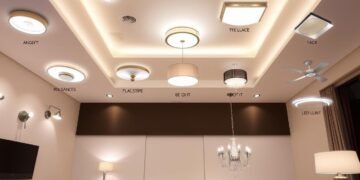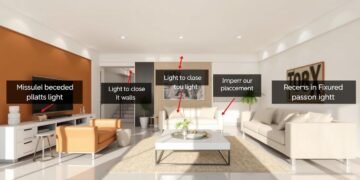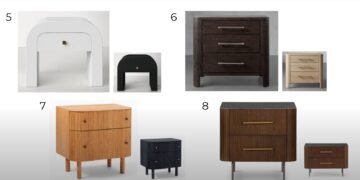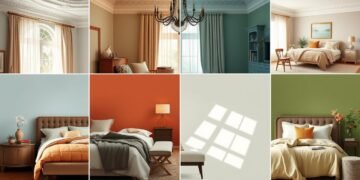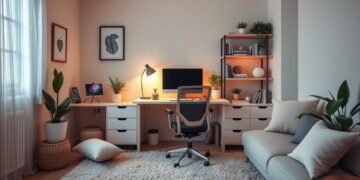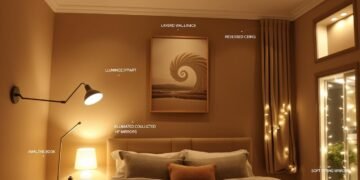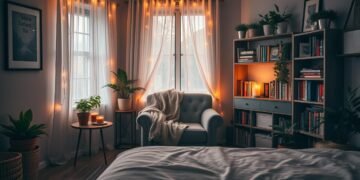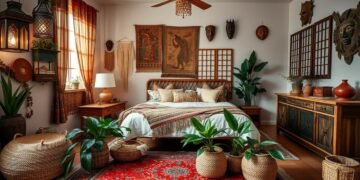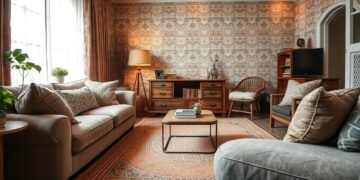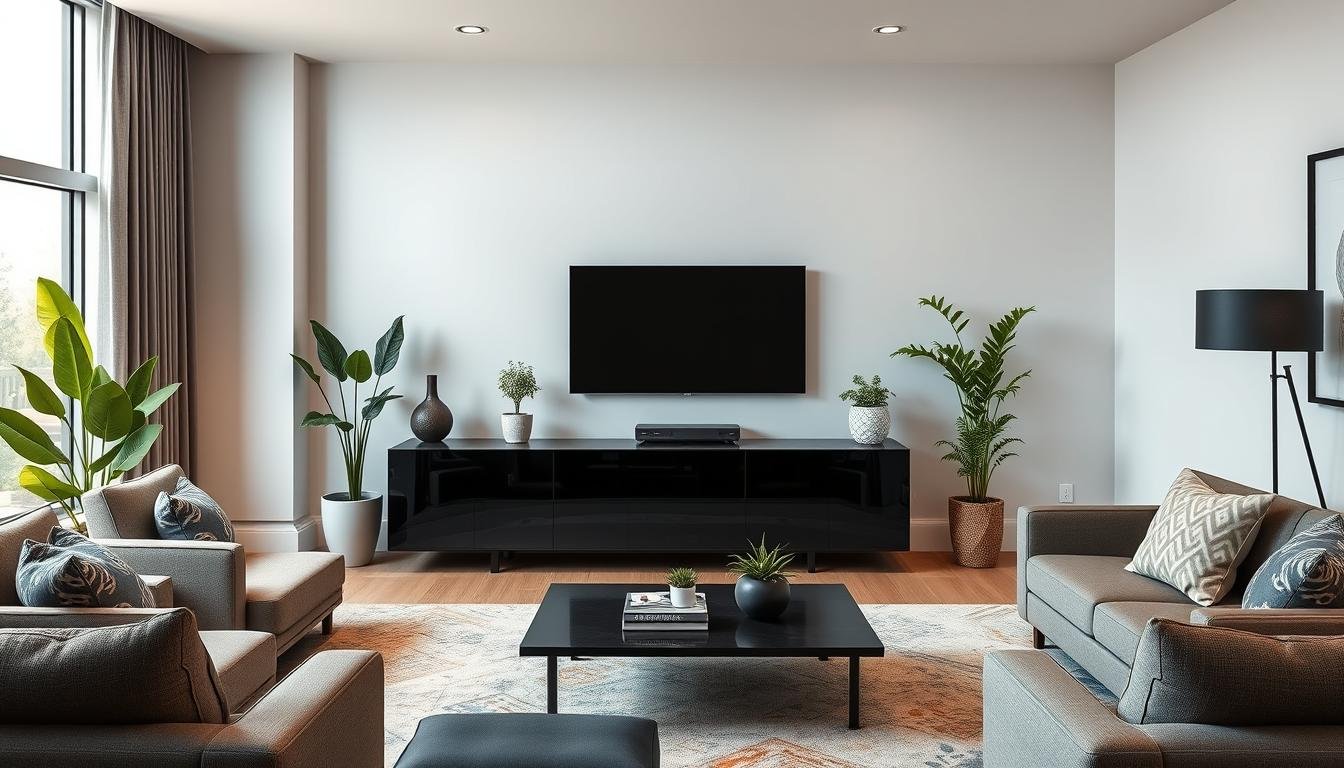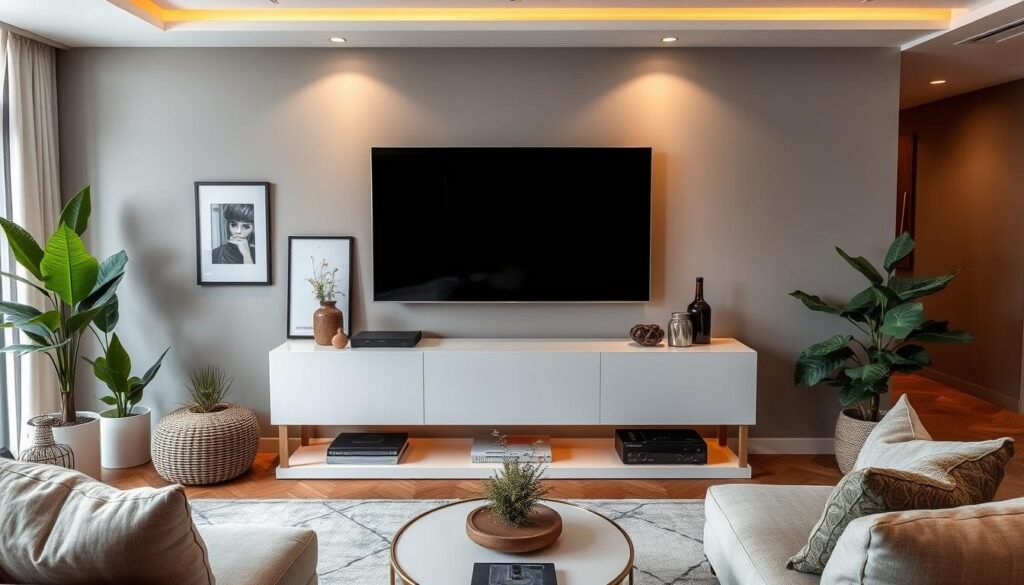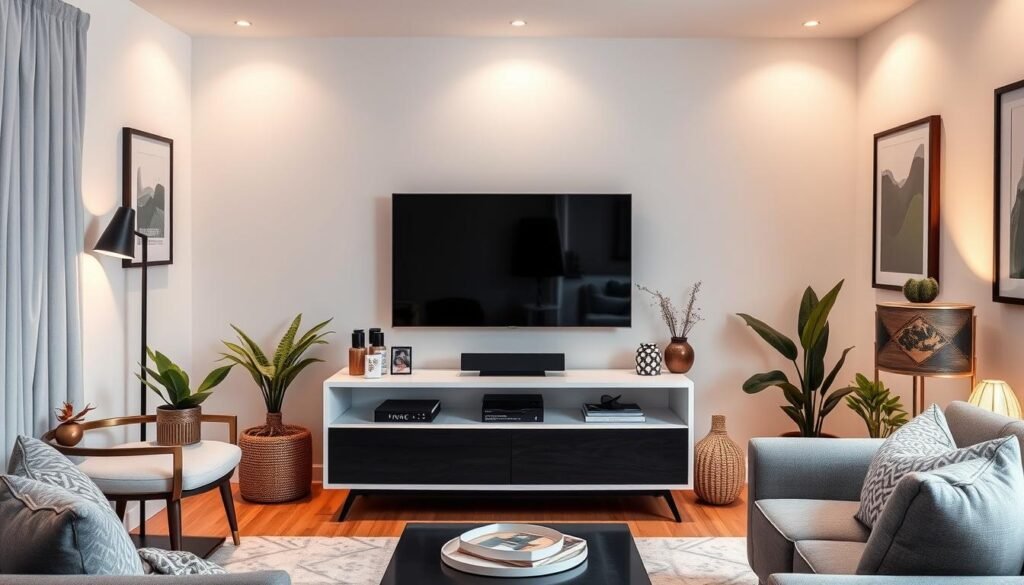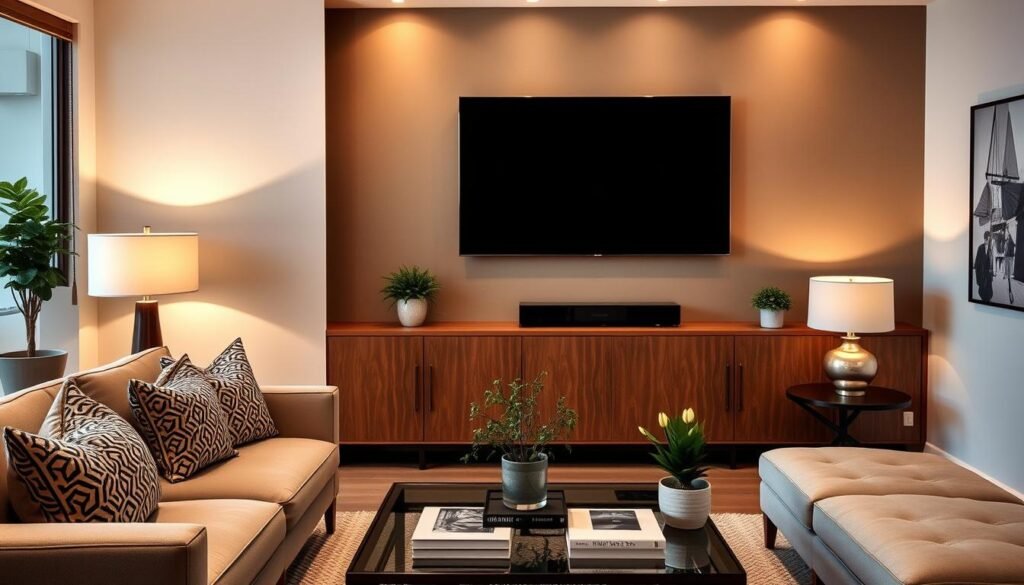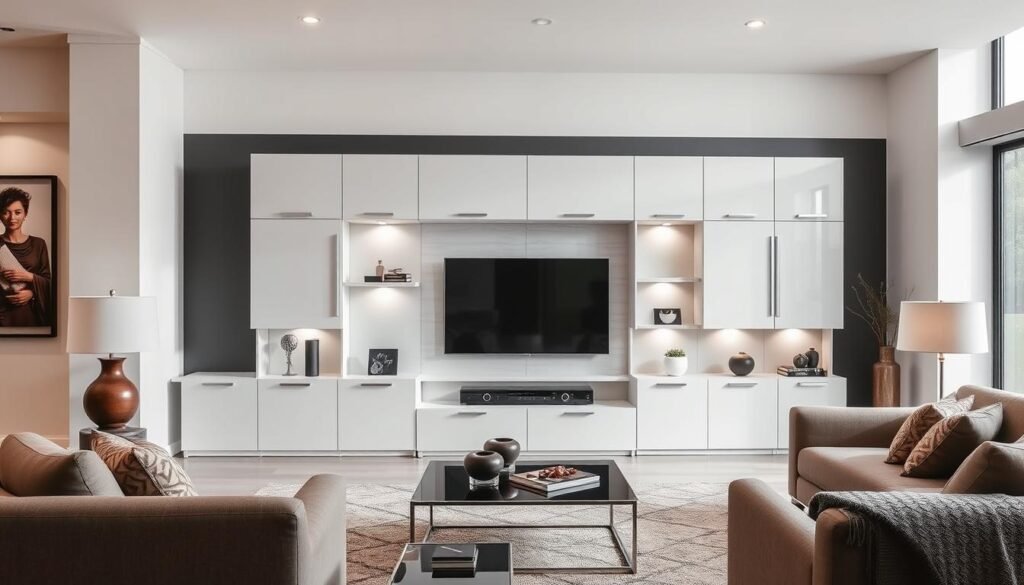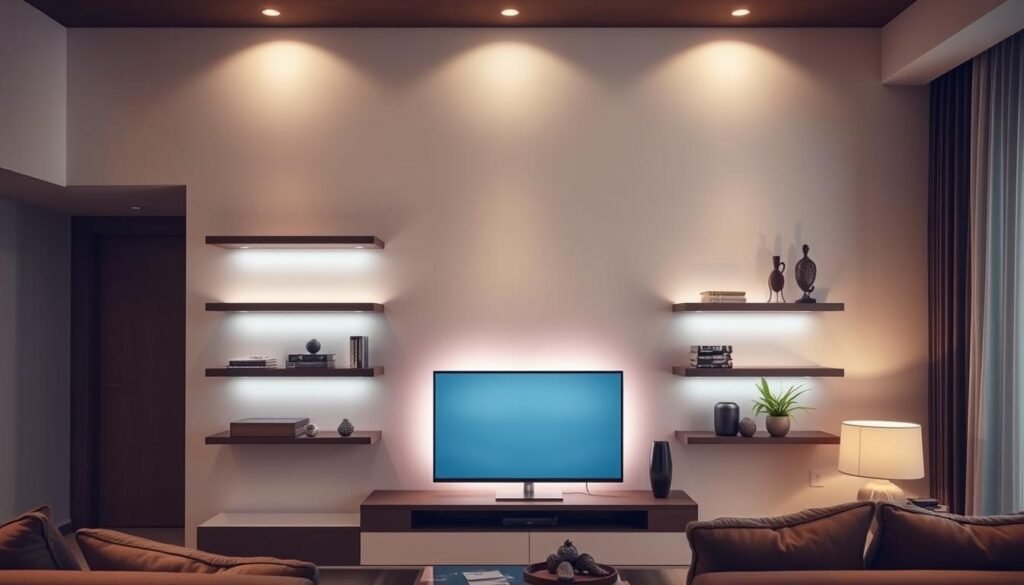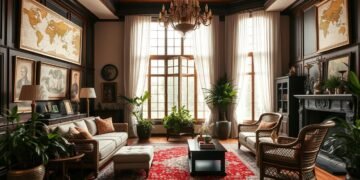Are you tired of your TV looking like an awkward intruder in your living room? What if you could make your TV part of your room’s design?
Modern living room design is all about blending technology with style. Your TV can actually make your room look better1.
Choosing the right spot for your TV is key. Think about the room’s layout, where you’ll sit, and how it looks. Whether your room is small or big, the right spot can make your TV look cool and planned2.
Table of Contents
- 1 Understanding the Fundamentals of TV Placement Design
- 1.1 Relatedarticles
- 1.2 Top 10 Iconic British Colonial Décor Elements to Infuse Classic Style into Your Home
- 1.3 5 Timeless Window Treatments That Will Perfectly Complement Classic Interiors
- 1.4 Bring Charm to Your Home: 6 Traditional Wall Paneling Designs You’ll Love
- 1.5 Determining Room Layout and Traffic Flow
- 1.6 Considering Viewing Angles and Distance
- 1.7 Assessing Natural Light Sources
- 2 TV Placement in Living Room: Essential Guidelines
- 3 Creating a Balanced Focal Point with Your TV
- 4 Smart Solutions for Small Living Spaces
- 5 Hidden TV Solutions and Creative Concealment
- 6 Optimal Mounting Heights and Technical Considerations
- 7 Incorporating Entertainment Units and Storage
- 8 Dark Wall and Monochromatic Approaches
- 9 Modern Technology Integration for Seamless Design
- 10 Lighting Strategies Around Your TV Setup
- 11 Conclusion
- 12 FAQ
- 12.1 What is the ideal viewing distance for a TV in a living room?
- 12.2 How high should I mount my TV for comfortable viewing?
- 12.3 What are the best ways to handle TV cables and reduce visual clutter?
- 12.4 How can I integrate my TV into my living room design without it becoming an eyesore?
- 12.5 What should I do if I have a small living room with limited space?
- 12.6 How do I reduce glare on my TV screen?
- 12.7 Can I make my TV a stylish focal point in the room?
- 12.8 What are the best lighting strategies for a TV area?
- 12.9 How do I choose the right TV size for my living room?
- 13 Source Links
Key Takeaways
- Transform your TV from a visual distraction to a design element
- Explore creative concealment techniques
- Balance functionality with aesthetic appeal
- Consider room layout and natural light sources
- Integrate technology seamlessly into your interior design
Understanding the Fundamentals of TV Placement Design
Creating the perfect living room layout is more than just placing a TV. It’s about strategic space planning. This includes considering many factors to make your room both comfortable and functional.
Good TV placement starts with knowing how furniture affects the room. You want a space that looks good and works well.
Determining Room Layout and Traffic Flow
When planning your room layout, keep these tips in mind:
- Maintain clear pathways between furniture pieces3
- Leave at least one foot of space between furniture and walls3
- Ensure seating is aimed at the primary focal point (TV)3
Considering Viewing Angles and Distance
For the best viewing, think about where to place the screen and where to sit. TVs between 39 to 55 inches should be 8 to 9 feet away for comfort4. Here’s how to place them:
| TV Size | Recommended Viewing Distance |
|---|---|
| 39-55 inches | 8-9 feet |
Don’t put TVs too high, as it can hurt your neck4. The best spot is one that lets you watch comfortably without pain.
Assessing Natural Light Sources
Natural light can change how you watch TV. Here’s how to handle it:
- Use room-darkening window treatments to reduce glare4
- Position the TV to minimize direct sunlight reflection
- Implement bias lighting behind the TV to reduce eye strain4
Pro tip: Create a visual mock-up using cardboard or painter’s tape to test TV placements before installing4.
Remember, room layout and viewing angle are important. Check your TV placement often to keep watching comfortable and enjoyable4.
TV Placement in Living Room: Essential Guidelines
Setting up your TV right is all about your living room’s layout and size. It’s about making your space both beautiful and comfy for watching TV5.
Here are some key tips for placing your TV:
- Choose a TV that fits your room well for the best viewing5
- Put the TV in the middle of where you sit for the best Netflix nights5
- Follow the recommended viewing distances for your screen size6
Most living rooms have TVs between 39 to 55 inches6. For these sizes, sit about eight to nine feet away for the best view without eye strain6.
“Your TV placement should create a harmonious balance between functionality and design,” say interior design experts.
Here are some things to avoid when placing your TV:
- Don’t hang TVs too high to avoid neck pain6
- Adjust the lights to reduce screen glare6
- Keep TVs away from sunlight and heat7
Pro tip: Use cardboard or tape to test TV placement before you install it6. Check your setup often to keep watching TV comfy6.
Creating a Balanced Focal Point with Your TV
Turning your TV into a stylish focal point needs careful planning. It’s about blending the TV into your decor and keeping the room balanced. This makes your living space look better.
Experts say to make your TV stand out without taking over the room. TVs are usually mounted 40 inches high for the best view8. The screen’s center should be a bit below your eye level for comfort9.
Integrating with Existing Architecture
When setting up your TV, look to match it with your home’s design. Good ideas include:
- Built-in shelves around the TV
- Custom cabinets that fit your home’s style
- Using architectural features for balance
Harmonizing with Room Decor
Your TV can be a part of your room’s look, not a distraction. Dark navy walls can make the TV less noticeable9. Here are some tips:
- Match your TV’s color to your room’s decor
- Balance the TV with decorative items
- Add mixed-texture accessories around the TV
Managing Visual Weight
To keep your room balanced, think about how your TV looks. Mix closed cabinets with open shelves for interest and storage9. Adding surround sound can also improve your viewing experience8.
“A well-placed TV transforms from a mere electronic device to an integral part of your home’s design narrative.”
Smart Solutions for Small Living Spaces
Designing a small living room needs creativity and smart planning. It’s about making every inch useful and stylish10. It’s not about giving up comfort, but finding clever ways to arrange things.
When making a multi-use room work, think about these smart TV placement ideas:
- Corner TV setups save wall space11
- Wall-mounted TVs look sleek and save space11
- Built-in shelves make the room look smooth and functional11
- Choose TV sizes that fit your room well11
Experts say to divide small spaces into clear zones10. Custom built-ins can be a big help, providing storage that fits your room’s shape10.
“In small spaces, every design choice must serve multiple purposes,” says Amanda Khouri from Amanda Khouri Interiors.
Try using clear surfaces, backlighting, and balancing your TV with art to make your room feel bigger and more interesting11.
Hidden TV Solutions and Creative Concealment
Today’s homeowners want to blend technology into their homes smoothly. They aim to keep their homes looking good while fitting in a smart TV. This need has led to creative ways in media storage and hidden TV designs12.
Experts have come up with many ways to hide TVs. They turn TVs into part of the home’s design. Invisible technology is now a key part of stylish homes12.
Sliding Artwork Covers
Sliding artwork covers are a smart way to hide TVs. They let you change your TV into art when it’s not on13.:
- 65% of design solutions involve integrating TVs into furniture or cabinetry
- 20% use artistic panels or mirrors to hide the TV
- 25% hide the TV in decorative elements
Custom Built-in Cabinets
Custom built-in cabinets are a great way to hide TVs. These special storage units keep your TV hidden while keeping your room looking good12.
Innovative Furniture Solutions
Innovative furniture offers many ways to hide TVs:
| Concealment Method | Design Approach |
|---|---|
| Ceiling Roll-Down | Discreet entertainment integration |
| Rotating Units | Flexible viewing angles |
| Hinged Panels | Artistic room transformation |
“Technology should enhance, not dominate, your living space.” – Design Expert
Using these creative hiding methods, you can mix tech with style perfectly13.
Optimal Mounting Heights and Technical Considerations
Finding the perfect tv mounting height is key for a comfy viewing spot. The right wall mount can change how you watch TV and keep you comfortable14.
When picking a tv mount, several important factors come into play. The ideal height should help avoid neck strain and ensure comfort15.
- Center of TV screen should be at eye level when seated
- Typical recommended height: 42-48 inches from floor
- Adjust based on specific room layout and furniture
Different TV sizes need different mounting setups. For example:
- 43-inch TV: Mount at 56 inches from floor16
- 55-inch TV: Position at 61 inches16
- 65-inch TV: Center around 65 inches16
Pro tip: Your viewing distance should be about 1.5 to 2.5 times the diagonal screen size for the best view14.
Technical aspects go beyond just height. Make sure there’s good airflow, the mount is secure, and ports are easy to reach. Remember, a well-planned wall mount isn’t just about looks—it’s about making a comfy, functional space for watching TV15.
Incorporating Entertainment Units and Storage
Creating the perfect entertainment center is all about mixing function and style. Your media cabinet is more than a TV stand. It’s a key piece that can change your living area and offer vital storage17.
Media Console Selection Strategies
When picking an entertainment center, think about these important points:
Innovative Cable Management Solutions
Good cable management keeps your space tidy and organized. Modern entertainment centers have built-in ways to hide wires. This makes your setup look neat and clean19.
| Cable Management Option | Benefits |
|---|---|
| In-wall Cable Routing | Wires are completely hidden |
| Built-in Cable Channels | Easy to organize and access |
| Cord Covers | A fast and cheap fix |
Accessory Organization Techniques
Custom entertainment centers have special spots for accessories. This keeps your space tidy17. Think about adding:
- Drawers for remotes
- Shelves for gaming systems
- Closed cabinets for media players
A well-designed entertainment center makes your living space truly special.
Pro tip: Choose a media cabinet that has both open and closed storage. This keeps things stylish and useful17.
Dark Wall and Monochromatic Approaches
Make your living space look amazing with a dark wall. It makes your TV wall mounting look better. A monochromatic design creates a stunning backdrop for your TV20. Black, blue, and green are top picks for a luxurious look21.
Choosing the right color is key. Here are some tips:
- Deep navy or charcoal gray make a sophisticated backdrop
- Match the dark color with built-ins for a unified look
- Try two-tone designs for depth and interest20
Designers say to balance bold colors with smart design choices. Medium-toned dark hues can make a room feel cozy and inviting without being too much21. Your TV wall should be a highlight that fits well with the room.
Pro Tip: When using a dark wall, think about the room’s light and design for a balanced look.
Dark walls can be tricky, but planning helps. Use neutral furniture to balance the bold wall22. Add geometric patterns or textures to your TV wall for more interest20.
With careful planning, your dark wall and TV mounting can make your living space look great. It will feel cozy and look amazing22.
Modern Technology Integration for Seamless Design
Today, making your living space seamless means using smart tvs and wireless tv setups. These technologies change how we enjoy entertainment. They make your home look great and work well23.
Modern streaming devices and smart home tech bring huge convenience. Now, you can control your whole entertainment system with voice commands or apps24.
- Centralized device control
- Wireless connectivity
- Aesthetic minimalism
- Energy-efficient solutions
Smart home systems grow with new tech. Here are some key ways to integrate:
| Technology | Benefits |
|---|---|
| Voice-Controlled TVs | Hands-free operation |
| Ambient Display Modes | Decorative when not in use |
| Wireless Speakers | Reduced cable clutter |
Tip: Choose smart devices that work together for a unified space.
Technology should make your life better, not harder.
By using wireless tvs and smart streaming devices, you turn your living room into a smart, connected area. It fits your lifestyle perfectly25.
Lighting Strategies Around Your TV Setup
Creating the perfect lighting for your TV setup is more than just turning on the lights. It’s about making your viewing experience better and adding style to your room26. It’s important to manage the lighting and reduce glare for both comfort and style.
LED strip lighting is a modern way to light up your entertainment area. By putting these lights behind your TV, you get many benefits:
- Reduce eye strain during long viewing times
- Make the picture look better
- Add a cool background glow
Reducing glare is key for great TV viewing26. Using room-darkening window treatments can cut down on light reflections. This makes your screen image clear and sharp. Experts say to place lamps and overhead lights carefully to avoid glare on the screen26.
“Lighting is not just about brightness, but about creating the right mood and visual comfort.” – Design Expert
Now, with smart lighting, you can control the lights like never before. Dimmable bulbs and smart systems let you change the light levels easily. This makes your space perfect for any activity26.
| Lighting Type | Best Use |
|---|---|
| Bias Lighting | Reduces eye strain, improves contrast |
| LED Strip Lighting | Provides atmospheric background illumination |
| Dimmable Overhead Lights | Adjustable brightness for different activities |
Lighting is an art. Try out different setups to find the perfect match for your TV and room style26.
Conclusion
Your living room design is more than furniture arrangement. It’s about creating a space that shows your style. TV placement is an artistic choice that makes your home entertainment area special27. When done right, your TV fits perfectly with your room’s look without losing its appeal.
Choosing the right spot for your TV means knowing about both function and style. Think about how furniture can improve talking and looking around27. You want your TV to be a part of the room’s beauty, not a distraction.
Every living room is different, so there’s no one-size-fits-all solution. Try out different TV spots, think about where you’ll sit, and focus on comfort. With smart planning, your TV can make your room feel both new and welcoming.
Good TV placement is all about making it your own. Listen to your gut, respect your home’s design, and don’t worry about following rules. Your living room should show off your story, with technology blending into it smoothly.
FAQ
What is the ideal viewing distance for a TV in a living room?
How high should I mount my TV for comfortable viewing?
What are the best ways to handle TV cables and reduce visual clutter?
How can I integrate my TV into my living room design without it becoming an eyesore?
What should I do if I have a small living room with limited space?
How do I reduce glare on my TV screen?
Can I make my TV a stylish focal point in the room?
What are the best lighting strategies for a TV area?
How do I choose the right TV size for my living room?
Source Links
- How to hide a TV – 14 clever ways to make your telly blend into the room
- How to Arrange An Awkward 10 x 12 Living Room with a Corner Fireplace and a TV — Michael Helwig Interiors
- 12 Rules for Arranging Living Room Furniture
- Mastering TV Placement: An Expert Guide for Optimal Viewing
- Where to Place the TV in the Living Room?
- Mastering TV Placement: An Expert Guide for Optimal Viewing
- Interior expert reveals the common TV placement mistakes you’re probably making
- The Elephant in the Room: How to Properly Place a Flat Screen TV in Your Living Room
- Style Your Living Room so the TV Doesn’t Steal the Show
- 37 Small Living Room Ideas for a Cozy Common Area
- 21 Small Living Rooms With TVs That Actually Look Good
- 4 Creative Ways to Hide Your TV
- 23 Clever Ways to Hide Your TV and Rid Your Space of the “Black Hole” Effect
- How High Should You Mount Your TV?
- Optimal TV Mounting Height: How High Should a TV Be Mounted?
- How High Should a TV Be Mounted and What is the Ideal Viewing Distance?
- 12 Built-In Entertainment Center Ideas: The Ultimate Guide
- How To Design Around A Screen – Studio McGee
- Where to Place the TV in Your Living Room
- Accent Wall Ideas That Will Make Your Living Room TV Area Pop
- Dark and Moody Color Palettes Are In—And These Living Rooms Prove It
- New This Week: 8 Ways to Place a TV in a Living Room
- Trio Development
- Seamless Smart Home Integration Solutions For Modern Living Spaces – HTZ Design+Build
- Designing Living Room Around Modern Television Experience
- Mastering TV Placement: An Expert Guide for Optimal Viewing
- Creating a Functional Living Room Layout – Colfax Furniture and Mattress




